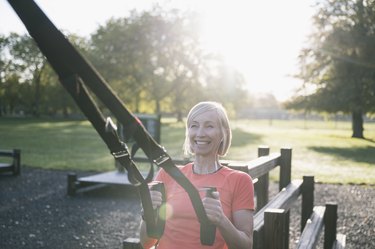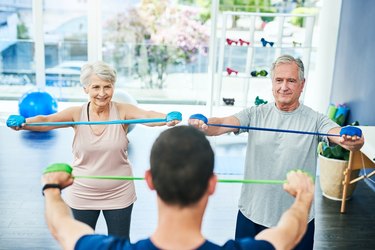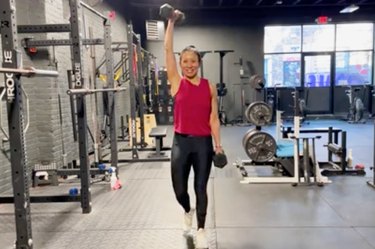

Strengthening your lower body is of prime importance for maintaining your balance and preventing falls as you age, but that doesn't mean you should neglect training your upper body.
As you get older, your upper-body muscles — including your shoulders and back — become weaker and tighter, especially if you sit for prolonged hours working in front of a computer. Doing posture-correcting moves, like the IYT exercise, can help with strengthening these muscles and releasing tension.
Video of the Day
"Older people start to experience shoulder or rotator cuff issues as they lose mobility and strength," Tina Tang, CPT, a New Jersey-based personal trainer who specializes in healthy aging, tells LIVESTRONG.com. "IYT raises focus on using your shoulder and back muscles. The position of our neck and shoulders when typing on a laptop or scrolling through a mobile phone patterns our bodies into a hunched posture. This exercise requires us to be cognizant of standing tall and using muscle groups neglected throughout a work day."
To get the most out of the IYT exercise, Tang recommends doing 2 sets of 10 reps twice a week. You can start out by doing the exercise with just your own body weight or with a pair of very light dumbbells, around 2 to 3 pounds.
"It's not about the volume but consistency. The strength and mobility of your shoulders increase with consistent attention to them," she says.
How to Do the IYT Raise Exercise
- Lie facedown on a stability ball and hold a dumbbell in each hand, palms facing each other. Reach your arms overhead.
- Keeping your arms straight, make the letter "I" by stretching from your fingertips to your toes. Aim to keep the rest of your body still throughout the movement.
- Then, lower your arms back down with control and lift them back up as a "Y," as if you're singing the YMCA.
- Next, lower your arms to the starting position and set them as a "T" before lifting them back up.
- Slowly lower your arms back down to the starting position. This is 1 rep.
- Do 2 sets of 10 reps.
Modifications
You can also do this exercise in a bent-over position or lying facedown (prone) on a bench.
Tip
- Imagine a string pulling your head up to the ceiling. Keep your collarbones spread as you lift the weights through the I, Y and T positions.
- Inhale when the dumbbells are down by your body, and exhale when you lift the weights up.
- Keep your shoulders away from your ears when you lift the dumbbells.
- Brace your core by filling the sides of your lower ribcage with air. Then, slowly exhale, lifting your pelvic muscles up and in, like an elevator, and dropping your ribcage down toward your pelvis.
Why the IYT Exercise Is Beneficial for Healthy Aging
1. It Improves Your Posture
Doing IYT raises can help undo your hunched shoulders and upper back by helping you stand taller.
As you go through the motions of forming an I, Y and T with your arms, you'll keep your shoulders away from you ears. This translates into real-life situations so you don't keep tension in your shoulders and learn how to properly engage your upper-body muscles while keeping your joints mobile.
2. It Strengthens Your Shoulder Muscles
The IYT exercise primarily targets your upper, middle and lower traps. It also works your rotator cuff muscles, including your supraspinatus, infraspinatus, teres minor and subscapularis, Tang says. These muscles are responsible for shoulder stability and mobility.
"With age, nearly everyone will complain about shoulder injury or pain. The rotator cuff muscles are the foundation of our shoulder joint movement and need strength and care throughout our lives," she says.
That's because as we age, our muscles generally become weaker and less mobile. As a result, older adults tend to experience more shoulder and rotator cuff issues.
People who have jobs that require repetitive overhead arm movements, like painting and carpentry, and those who play tennis, baseball or do weightlifting have an increased risk of rotator cuff injuries, according to the Mayo Clinic.
"Our bodies compensate and try to move in other ways to fit in the movement. This is when inflammation or injuries occur. It's important to give your joints attention and care in our younger years with strength training and movement," Tang says.
3. It Helps You Maintain Shoulder Mobility
Shoulder mobility allows you to carry out everyday tasks, like reaching for items on a top shelf, washing your back in the shower and hoisting heavy grocery bags to your shoulders. As you get older, your mobility declines due to a number of factors, like arthritis, chronic pain and living a more sedentary lifestyle.
"Arthritis care demands strength and exercise. The IYT raises improve mobility through movement and strength. With age, the idea of 'use it or lose it' never was more relevant in regards to shoulder strength," Tang says.
Was this article helpful?
150 Characters Max
0/150
Thank you for sharing!
Thank you for your feedback!


